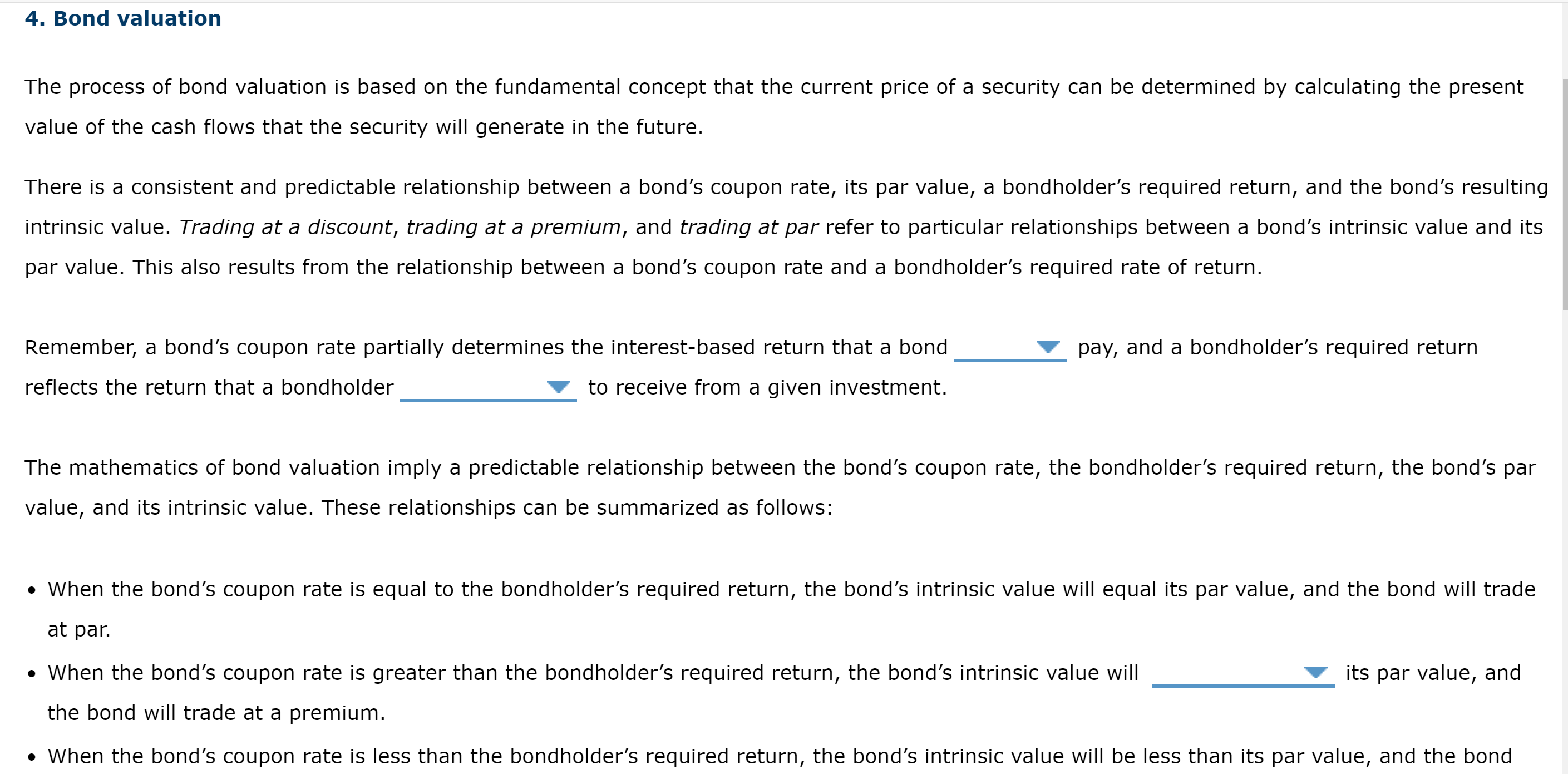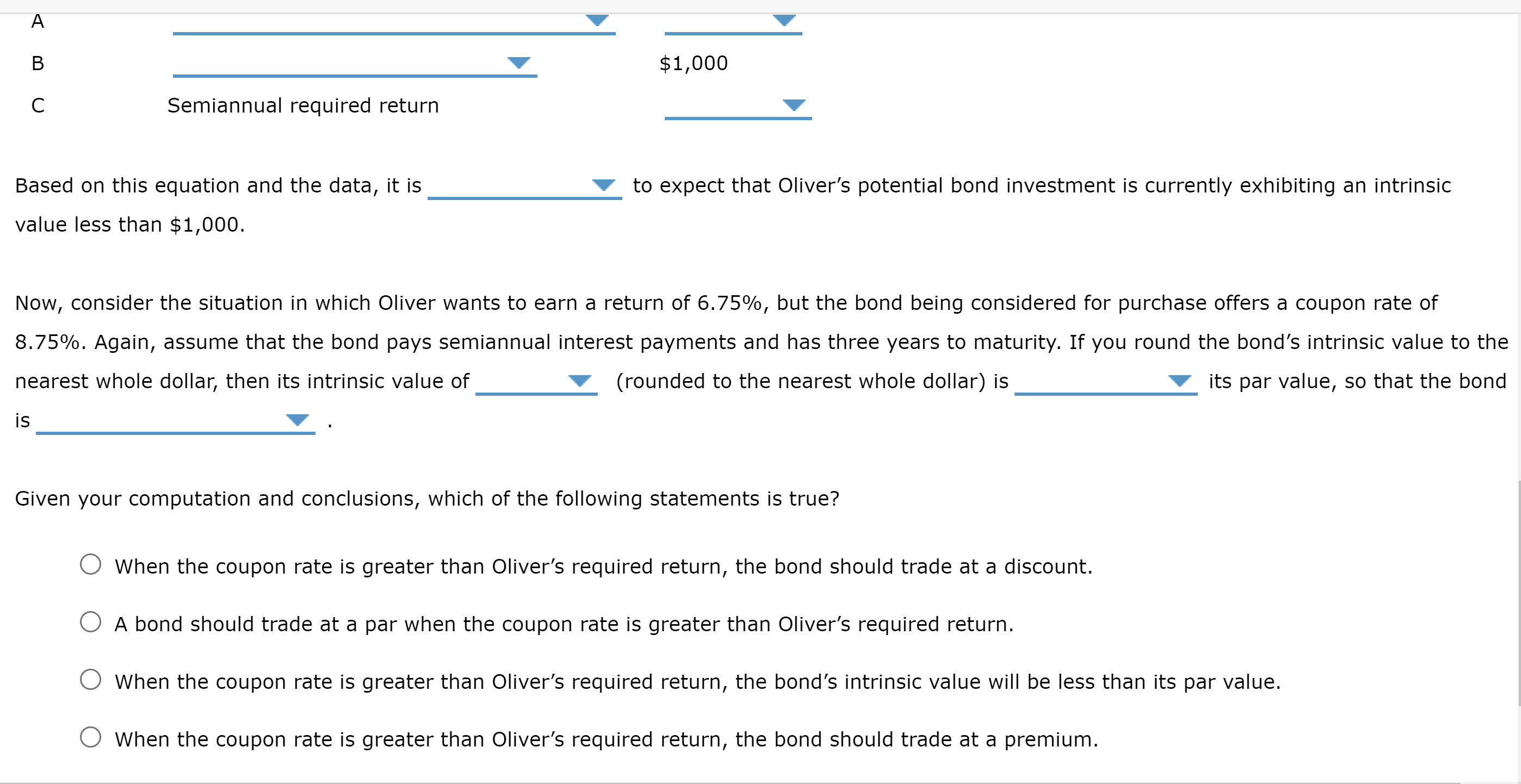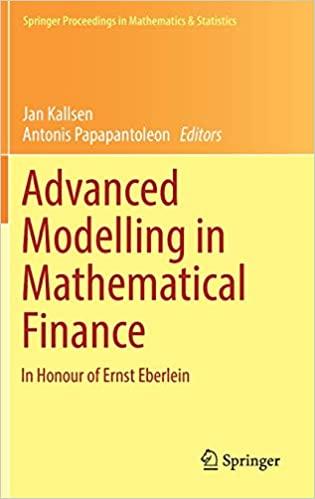Answered step by step
Verified Expert Solution
Question
1 Approved Answer
The process of bond valuation is based on the fundamental concept that the current price of a security can be determined by calculating the present


 The process of bond valuation is based on the fundamental concept that the current price of a security can be determined by calculating the present value of the cash flows that the security will generate in the future. There is a consistent and predictable relationship between a bond's coupon rate, its par value, a bondholder's required return, and the bond's resulting intrinsic value. Trading at a discount, trading at a premium, and trading at par refer to particular relationships between a bond's intrinsic value and its par value. This also results from the relationship between a bond's coupon rate and a bondholder's required rate of return. Remember, a bond's coupon rate partially determines the interest-based return that a bond pay, and a bondholder's required return reflects the return that a bondholder to receive from a given investment. The mathematics of bond valuation imply a predictable relationship between the bond's coupon rate, the bondholder's required return, the bond's par value, and its intrinsic value. These relationships can be summarized as follows: - When the bond's coupon rate is equal to the bondholder's required return, the bond's intrinsic value will equal its par value, and the bond will trade at par. - When the bond's coupon rate is greater than the bondholder's required return, the bond's intrinsic value will its par value, and the bond will trade at a premium. - When the bond's coupon rate is less than the bondholder's required return, the bond's intrinsic value will be less than its par value, and the bond - When the bond's coupon rate is less than the bondholder's required return, the bond's intrinsic value will be less than its par value, and the bond will trade at For example, assume Oliver wants to earn a return of 10.50% and is offered the opportunity to purchase a $1,000 par value bond that pays a 8.75% coupon rate (distributed semiannually) with three years remaining to maturity. The following formula can be used to compute the bond's intrinsic value: IntrinsicValue=(1+C)1A+(1+C)2A+(1+C)3A+(1+C)4A+(1+C)5A+(1+C)6A+(1+C)6B Complete the following table by identifying the appropriate corresponding variables used in the equation. Now, consider the situation in which Oliver wants to earn a return of 6.75%, but the bond being considered for purchase offers a coupon rate of 8.75%. Again, assume that the bond pays semiannual interest payments and has three years to maturity. If you round the bond's intrinsic value to the nearest whole dollar, then its intrinsic value of (rounded to the nearest whole dollar) is its par value, so that the bond The process of bond valuation is based on the fundamental concept that the current price of a security can be determined by calculating the present value of the cash flows that the security will generate in the future. There is a consistent and predictable relationship between a bond's coupon rate, its par value, a bondholder's required return, and the bond's resulting intrinsic value. Trading at a discount, trading at a premium, and trading at par refer to particular relationships between a bond's intrinsic value and its par value. This also results from the relationship between a bond's coupon rate and a bondholder's required rate of return. Remember, a bond's coupon rate partially determines the interest-based return that a bond pay, and a bondholder's required return reflects the return that a bondholder to receive from a given investment. The mathematics of bond valuation imply a predictable relationship between the bond's coupon rate, the bondholder's required return, the bond's par value, and its intrinsic value. These relationships can be summarized as follows: - When the bond's coupon rate is equal to the bondholder's required return, the bond's intrinsic value will equal its par value, and the bond will trade at par. - When the bond's coupon rate is greater than the bondholder's required return, the bond's intrinsic value will its par value, and the bond will trade at a premium. - When the bond's coupon rate is less than the bondholder's required return, the bond's intrinsic value will be less than its par value, and the bond - When the bond's coupon rate is less than the bondholder's required return, the bond's intrinsic value will be less than its par value, and the bond will trade at For example, assume Oliver wants to earn a return of 10.50% and is offered the opportunity to purchase a $1,000 par value bond that pays a 8.75% coupon rate (distributed semiannually) with three years remaining to maturity. The following formula can be used to compute the bond's intrinsic value: IntrinsicValue=(1+C)1A+(1+C)2A+(1+C)3A+(1+C)4A+(1+C)5A+(1+C)6A+(1+C)6B Complete the following table by identifying the appropriate corresponding variables used in the equation. Now, consider the situation in which Oliver wants to earn a return of 6.75%, but the bond being considered for purchase offers a coupon rate of 8.75%. Again, assume that the bond pays semiannual interest payments and has three years to maturity. If you round the bond's intrinsic value to the nearest whole dollar, then its intrinsic value of (rounded to the nearest whole dollar) is its par value, so that the bond
The process of bond valuation is based on the fundamental concept that the current price of a security can be determined by calculating the present value of the cash flows that the security will generate in the future. There is a consistent and predictable relationship between a bond's coupon rate, its par value, a bondholder's required return, and the bond's resulting intrinsic value. Trading at a discount, trading at a premium, and trading at par refer to particular relationships between a bond's intrinsic value and its par value. This also results from the relationship between a bond's coupon rate and a bondholder's required rate of return. Remember, a bond's coupon rate partially determines the interest-based return that a bond pay, and a bondholder's required return reflects the return that a bondholder to receive from a given investment. The mathematics of bond valuation imply a predictable relationship between the bond's coupon rate, the bondholder's required return, the bond's par value, and its intrinsic value. These relationships can be summarized as follows: - When the bond's coupon rate is equal to the bondholder's required return, the bond's intrinsic value will equal its par value, and the bond will trade at par. - When the bond's coupon rate is greater than the bondholder's required return, the bond's intrinsic value will its par value, and the bond will trade at a premium. - When the bond's coupon rate is less than the bondholder's required return, the bond's intrinsic value will be less than its par value, and the bond - When the bond's coupon rate is less than the bondholder's required return, the bond's intrinsic value will be less than its par value, and the bond will trade at For example, assume Oliver wants to earn a return of 10.50% and is offered the opportunity to purchase a $1,000 par value bond that pays a 8.75% coupon rate (distributed semiannually) with three years remaining to maturity. The following formula can be used to compute the bond's intrinsic value: IntrinsicValue=(1+C)1A+(1+C)2A+(1+C)3A+(1+C)4A+(1+C)5A+(1+C)6A+(1+C)6B Complete the following table by identifying the appropriate corresponding variables used in the equation. Now, consider the situation in which Oliver wants to earn a return of 6.75%, but the bond being considered for purchase offers a coupon rate of 8.75%. Again, assume that the bond pays semiannual interest payments and has three years to maturity. If you round the bond's intrinsic value to the nearest whole dollar, then its intrinsic value of (rounded to the nearest whole dollar) is its par value, so that the bond The process of bond valuation is based on the fundamental concept that the current price of a security can be determined by calculating the present value of the cash flows that the security will generate in the future. There is a consistent and predictable relationship between a bond's coupon rate, its par value, a bondholder's required return, and the bond's resulting intrinsic value. Trading at a discount, trading at a premium, and trading at par refer to particular relationships between a bond's intrinsic value and its par value. This also results from the relationship between a bond's coupon rate and a bondholder's required rate of return. Remember, a bond's coupon rate partially determines the interest-based return that a bond pay, and a bondholder's required return reflects the return that a bondholder to receive from a given investment. The mathematics of bond valuation imply a predictable relationship between the bond's coupon rate, the bondholder's required return, the bond's par value, and its intrinsic value. These relationships can be summarized as follows: - When the bond's coupon rate is equal to the bondholder's required return, the bond's intrinsic value will equal its par value, and the bond will trade at par. - When the bond's coupon rate is greater than the bondholder's required return, the bond's intrinsic value will its par value, and the bond will trade at a premium. - When the bond's coupon rate is less than the bondholder's required return, the bond's intrinsic value will be less than its par value, and the bond - When the bond's coupon rate is less than the bondholder's required return, the bond's intrinsic value will be less than its par value, and the bond will trade at For example, assume Oliver wants to earn a return of 10.50% and is offered the opportunity to purchase a $1,000 par value bond that pays a 8.75% coupon rate (distributed semiannually) with three years remaining to maturity. The following formula can be used to compute the bond's intrinsic value: IntrinsicValue=(1+C)1A+(1+C)2A+(1+C)3A+(1+C)4A+(1+C)5A+(1+C)6A+(1+C)6B Complete the following table by identifying the appropriate corresponding variables used in the equation. Now, consider the situation in which Oliver wants to earn a return of 6.75%, but the bond being considered for purchase offers a coupon rate of 8.75%. Again, assume that the bond pays semiannual interest payments and has three years to maturity. If you round the bond's intrinsic value to the nearest whole dollar, then its intrinsic value of (rounded to the nearest whole dollar) is its par value, so that the bond Step by Step Solution
There are 3 Steps involved in it
Step: 1

Get Instant Access to Expert-Tailored Solutions
See step-by-step solutions with expert insights and AI powered tools for academic success
Step: 2

Step: 3

Ace Your Homework with AI
Get the answers you need in no time with our AI-driven, step-by-step assistance
Get Started


